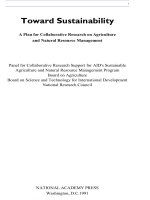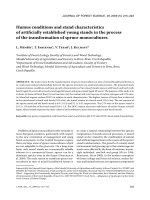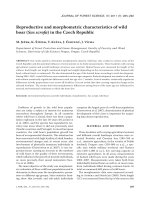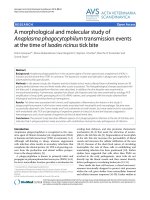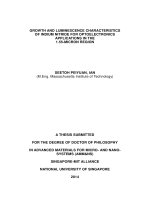Research on physiological and anatomical characteristics of afzelia xylocarpa ((Kurz) craib at the nursery
Bạn đang xem bản rút gọn của tài liệu. Xem và tải ngay bản đầy đủ của tài liệu tại đây (249.47 KB, 6 trang )
Biotechnology and Seedling
RESEARCH ON PHYSIOLOGICAL AND ANATOMICAL
CHARACTERISTICS OF AFZELIA XYLOCARPA (KURZ) CRAIB
AT THE NURSERY
Sounthone Douangmala1, Nguyen Van Viet2, Do Quang Trung2, Tran Viet Ha2
1
2
Bolykhamxay College of Agriculture and Forestry, Vientiane, Laos
Vietnam National University of Forestry
SUMMARY
Afzelia xylocarpa (Kurz) Craib is a high economic value plantation with many significant characteristics such
as durable and beautifully patterned wood well tolerated in environmentally stressed conditions. This paper
provides preliminary results about anatomical and physiological characteristics of Afzelia xylocarpa planting at
the nursery. The result shows that Afzelia xylocarpa has some interesting phenotypes such as ratio of palisade and
spongy parenchyma, 0.71, no multi-epidermis or covered hair. In addition, the result presents the stomata which
lies horizontally with the epidermal layer where the average number is 602/mm2 and the total content of
chlorophyll in fresh leaves is 10.42 mg/g with the ratio of a/b chlorophylls 1.49. The physiological data
illustrates the evapotranspiration intensity, 0.63 g/dm2/h, and the water absorption figure, 14.09 atm. Moreover,
the result also indicates that different temperatures (45, 50 and 600C) had a different effect on leaf tissues that
was demonstrated by damaged/fresh ratios, 14.5%, 72% and 100%, respectively. All the above evidence suggests
that Afzelia xylocarpa may need a medium intensity of light, would lose water easily and shows weak ability to
water adsorption. These might play important roles in planting Afzelia xylocarpa in the future.
Keywords: Afzelia xylocarpa, anatomical characteristics, chlorophyll, physiological characteristics, stomata.
1. INTRODUCTION
Afzelia xylocarpa (Kurz) Craib, known as
te or Ho bi or Teakha, belongs to Fabaceae
family, Caesalpinoideae sub-family. They are
big plants at 30 meters high with a trunk
diameter, reaching 2 meters. They distribute
at evergreen or semi-deciduous forestry, wet or
semi tropical condition zones. They have been
found in Lao (Bolykhamxay, Vienchan city),
Vietnam (Kon Tum, Gia Lai, Dac Lac, Khanh
Hoa and East-Southern provinces), Thailan and
Myanmar. In nature, they were distributed not
in a population but in an individual plant
among other species in the forestry (Nguyen
Hoang Nghia, 1999).
According to Vietnam’s Red Book (2007),
Afzelia xylocarpa was classified as EN A1c, d.
Their wood is very popular in the market,
especially in Lao, because of the flexibility in
many applications such as house building,
furniture, high-quality hand-made furniture
(Nguyen Duc Thanh et al., 2012, Nguyen Duc
Thanh, 2016). Notably, the numbers of Afzelia
12
xylocarpa in natural forestry are very low and
is endangered for sources of important genes
from native plants (Nguyen Hoang Nghia,
1999).
Currently, there are some studies for this
plant reported. However, most of them studied
on
phenotypical
and
eco-systemic
characteristics and not yet on anatomical and
physiological characteristics. These lead to
problems to optimize the environmental
conditions for planting at the nursery stage of
Afzelia xylocarpa. Therefore, to get more
scientific knowledge that may help in breeding
Afzelia xylocarpa, we carried out research on
the
anatomical
and
physiological
characteristics of this plant.
2. RESEARCH METHODOLOGY
2.1. Material
Fresh leaves of 6-month old
Afzelia
xylocarpa plantlets growing in a nursery ,
being planted in the College of Forestry
Biotechnology, Vietnam National University of
Forestry.
JOURNAL OF FORESTRY SCIENCE AND TECHNOLOGY NO. 7 (2019)
Biotechnology and Seedling
2.2. Methods
cell (Stb) is equal to the one of isotonic solution
Anatomy: leaf samples of three different
species were randomly chosen., Three different
positions on each leaf sample were anatomized
and data collected
of the total number of
stomata on under-leaf surfaces or the thickness
of layers under the OPTIKA M-699 microscope
link Optikam PRO 3 Digital Camera.
Identify the content and ratio of chlorophyll a
and b as described in Benz et al. (1980).
Identify the evaporation intensity of water as
method described in Ivanov et al. (1950).
Identify water adsorption of plant tissues as
methods described by Shacdacov: Briefly, two
series of 10 falcon tubes was prepared, one for
standard curve and one for experiment, which is
containing NaCl solution with concentration
from
0.1
to
1M
(0.1M
difference).
Consequently, two parallel tubes had the same
concentration. Then, 2 and 3mL of NaCl
solution were added into the series of standard
and experimental tubes, respectively. In the next
step, we used a wine-opener to collect pieces
of samples and placed 5 pieces per tube. Then,
these tubes were incubated at room temperature
for 30 minutes and occasionally mixed by gentle
shaking. After that, the pieces of samples were
taken out and we added 1 drop of methylene
blue. The mixture was well shaken
and
a
pipet used to suck up the solution from
experimental tubes and slowly poured into
parallel standard tubes. During this step, the
movement of blue solution was carefully
observed to find a concentration in which the
blue solution did not move meaning the
concentration of the cytoplasm of cell (Ctb) is
equal to the one of NaCl solution (Cdd). This
concentration
is
called
the
isotonic
concentration. Hence, the water adsorption of
(Sdd).
Stb = Sdd = R. T. Ci
In which: Stb: water adsorption of cell; Sdd:
water adsorption of isotonic solution; R =
0,0821 = air constants; C: the concentration of
the cytoplasm of cell; i: isotonic constants; i = 1
+ α (n-1); α: electronic fraction; n: ion
numbers after an electronic reaction.
Identify the heat tolerance by using methods
of Maxcop: Briefly, water was boiled and a
series of cups were prepared to contain water
with different temperatures: 350 C, 400 C, 450 C,
500 C, 550 C, 600 C. Then, leaf samples were
immersed in these cups for 30 minutes. After
that, the immersed samples were transferred
into a cup containing room-temperature water
for 2 - 5 minutes. Then, the water was discarded
and added HCl 0.2 N solution. The mixture was
incubated for 20 minutes before taking out the
leaf samples to measure the damaged area (%).
Experiments: 1) ĐC: No sunlight; 2) CS1:
25% shaded; 3) CS2: 50% shaded; 4) CS3: 75%
shaded.
3. RESULTS AND DISCUSSIONS
3.1. Leaf anatomy
Epidermis and Curtin are outside layers of
leaf that play important roles in the protection
and reduction of water evaporation for inner
layers. In addition, they also carry out many
other processes. In addition, the size of
epidermis cells or the thickness of the curtin
layer is evidence for the adaptation with
non-desired environmental conditions such as
highly intensive sunlight. Hence, studying the
epidermis layer plays an important role in
planting and caring for Afzelia xylocarpa
plantlets. Interestingly, the result shows that
both sides of a leaf of Afzelia xylocarpa do not
have multi-layer epidermis and the Curtin-layer
thickness is relatively constant suggesting the
light adsorption is the same on both sides of a
leaf (Table 1 and Figure 1).
JOURNAL OF FORESTRY SCIENCE AND TECHNOLOGY NO. 7 (2019)
13
Biotechnology and Seedling
Table 1. Anatomic analysis of a leaf
Average value of anatomic factors (µm)
Exp.
MD/
MK
Total
stoma/mm2
CTT
BBT
MD
MK
BBD
CTD
Leaf
thickness
CS1
3.28
3.25
16.25
15.74
36.06
32.76
49.10
45.85
12.56
12.04
3.50
4.38
120.75
114.02
0.73
0.71
616
604
CS2
3.16
10.80
32.08
45.64
9.04
3.03
103.75
0.70
599
CS3
3.09
10.55
29.48
43.34
8.92
2.91
98.29
0.68
589
ĐC
Average 3.20
13.33
32.59
45.98
10.64
3.45
109.20
0.71
602
Notes: CTT: upper cutin; BBT: upper epidermis; MD: palisade layer; MK: spongy layer; BBD: lower
epidermis; CTD: lower cutin; KK: stomata.
The results described in Table 1 presents the
MD/MK ratio of about 0.71, suggesting the
above medium requirement of light for Afzelia
xylocarpa leaves. In addition, the anatomic
analysis also
shows that both layers of
epidermis do not have covered hairs, which are
dead cells containing air and play significant
roles in light reflection and heat relief of leaves.
MD
Furthermore, the stomata located horizontally
with epidermis cells and average number of
stomata per 01 mm2 is 602, which is different
from other plants such as Manglietia conifera
(199/mm2), Erythrophleum fordii (464/mm2),
red eucalyptus (486/mm2), K. senegalensis
(929/mm2), and white eucalyptus (420/mm2)
(Nguyen Thi Tho et al., 2013).
MK
(a)
(b)
KK
Figure 1. Leaf anatomic picture
(a) Cross section of leaf blade ; b) Shape and number of stomata)
3.2. Qualitative analysis of chlorophyll from
leaves of Afzelia xylocarpa
Chlorophylls play important roles in plant
synthesis, which produce inorganic compounds
from carbon dioxide and water with the
catalysis of sunshine. Interestingly, many
studies have been done on photophilic plants
and demonstrated that photophilic plants have a
small number of chlorophylls and a high ratio
of chlorophyll a/b (about 5.5). On the other
side, the photophobic plants shows opposite
14
features such as a high number of chlorophyll
and low chlorophyll a/b ratio (≤ 1.4). Therefore,
the light demand of a plant can be
demonstrated by two factors including the
chlorophyll amount and ratio of chlorophyll a/b
(Vu Van Vu et al., 2000).
To find out the light demand of Afzelia
xylocarpa plantlets, we analyzed the
chlorophyll amount in leaf samples collected
from differently shaded plantlets. The results
are shown in table 2.
JOURNAL OF FORESTRY SCIENCE AND TECHNOLOGY NO. 7 (2019)
Biotechnology and Seedling
Table 2. Amount of chlorophyll in a leaf of Afzelia xylocarpa plantlet
Amount of chlorophylls (mg/g)
Chlorophyll a
Chlorophyll b
Total
Ratio of
chlorophyll (a/b)
ĐC
5.92
4.01
9.94
1.76
CS1
6.25
3.99
10.23
1.57
CS2
6.20
4.19
10.39
1.48
CS3
5.90
5.21
11.11
1.13
Average
6.07
4.35
10.42
1.49
Exp.
As can be seen from table 2, the average
amount of chlorophyll a and b from Afzelia
xylocarpa leaf is 6.06 and 4.35 mg/g,
respectively. The total amount of chlorophyll is
10.42 mg per gram of fresh leaf and the
chlorophyll (a/b) ratio is 1.49. These data
illustrate that Afzelia xylocarpa plantlet adapts
in medium sunlight.
3.3. Evaporation intensity of leaves
The experiments were carried out at The
College of Forestry University, Vietnam
National University of Forestry. Environmental
conditions in this location include light intensity
(3000 lux), humidity (77%), temperature
(300C). The data were collected, analyzed, and
presented as in table 3.
Table 3. Water evaporation intensity and water adsorption force of leaves
Exp.
Water evaporation intensity (g/dm2/h)
water adsorption force (atm)
ĐC
0.69
17.21
CS1
0.66
15.15
CS2
0.64
13.06
CS3
0.51
10.95
Average
0.63
14.09
3.3.1. Evaporation intensity of water
It is already known that the water
evaporation of leaves plays important roles in
the cooling down process of plants and in
generating forces to transfer water and minerals
from roots to the leaves. Hence, analyzing the
water evaporation of leaves can reveal the
demand of water and minerals for a plant as well
as the plant development. In this paper, the
results showed that an average value of water
evaporation intensity is 0.63 g/dm2/h presenting
the slow evaporation of leaf samples (Table 3).
The results are consistent with previous studies
that suggest medium requirement of sunlight for
plantlets of Afzelia xylocarpa.
3.3.2. Water adsorption force of leaf cells
Drought tolerance of plants seriously
involves to concentration of metabolites in the
cell cytoplasm, which plays significant role in
producing adsorption force for roots. The results
are described as in table 3. As can be seen, the
water evaporation force of leaf cells is about
14.09 atm. This value is smaller than the one of
drought-tolerance plants such as Casuarina
Adans (19.86 atm) suggesting plantlets of
Afzelia xylocarpa have just above medium
demand for water. This is consistent with the
results that presented the low evaporation of
leaves (3.3.1 section).
These figures together with the anatomic
results demonstrated that the plantlets of Afzelia
xylocarpa
easily
lose water through
evaporation of leaves but their ability in water
adsorption is very low. This leads to problems
JOURNAL OF FORESTRY SCIENCE AND TECHNOLOGY NO. 7 (2019)
15
Biotechnology and Seedling
in planting and caring for plantlets in dry and
hot conditions.
3.4. Heat tolerance of Afzelia xylocarpa
Temperature, sunlight and humidity play
significant roles on annual, seasonal, or day and
night activities of organisms. High temperature
showed functions in producing regional
distribution and classification of plants. Hence,
studying effects of temperature on plantlets is
very necessary. The results were presented in
table 4.
Table 4. Heat tolerance of Afzelia xylocarpa
Damaged percentage of leaves (%)
Exp.
350 C
400 C
450 C
500 C
550 C
600 C
ĐC
0
1
12
66
99
100
CS1
0
3
14
69
100
100
CS2
0
6
15
74
100
100
CS3
0
7
17
79
100
100
Average
0
4.25
14.50
72.0
99.75
100
350 C
400 C
450 C
500 C
550 C
600 C
Figure 2. Percentage of damaged area of leaves under different temperatures
As can be seen, leaf samples have low heat
tolerance (Figure 2): no damaged leaves were
found at 350C, but when the temperature rose up
to 400C, many small damaged areas appeared.
Notably, at 45 and 500C, the percentage of
damaged areas dramatically increased reaching
14.5 and 72%. Moreover, the leaf color changed
from green into light brown at 500C. This result
suggests the cell membranes were damaged
leading to HCl entering and causing a damage
of cytoplasm components and chlorophylls. In
addition, the results also showed that 99.75% of
a leaf have been turned into dark brown with a
very small green area at 550C, and especially,
there is no longer any green color at 600C. As
previous studies at Nui Luot location, the
temperature can reach to 430 C on June and
16
average temperature is 23.10C. All of these
suggest the leaves can be affected in June and
may lead to defects in plant development.
4. CONCLUSION
Through the physiological and anatomical
experiments of leaves of Afzelia xylocarpa, our
results showed that: 1) The leaves do not have
multiple layer epidermis and covered hair. In
addition, the ratio of palisade layer/ spongy
layer is about 0.71; 2) The stomata lies
horizontally with epidermis cells and an
average number of stomata is 602/mm2; 3) The
amount of chlorophyll in a and b from fresh
leaves is 6.07 and 4.35 mg/g, respectively; 4)
Water evaporation intensity is 0.63 g/dm2/h
and water adsorption force are 14.09 atm; 5)
The percentage of damaged area is 14.5, 72 and
JOURNAL OF FORESTRY SCIENCE AND TECHNOLOGY NO. 7 (2019)
Biotechnology and Seedling
100% at 45, 50 and 600 C, respectively. This
data suggests that Afzelia xylocarpa has a
medium requirement of light and might be
useful for further experiments in future.
REFERENCES
1. Ministry of Science and Technology, Vietnam
Academy of Science and Technology (2007). Vietnam
red data book: Part 2 – Plants. Sciences and Technics
Publishing house, Ha Noi.
2. Cutler D.F, Botha T, Stevenson D (2008). Plant
Anatomy. An applied approach. Blackwell Publishing.
3. Fahn A., (1982). Plant Anatomy. Pergamon Press.
4. Nguyen Duc Thanh, Le Thi Bich Thuy and
Nguyen Hoang Nghia (2012). Genetic diversity of
Afzelia xylocarpa in Vietnam based on analyses of
chloroplast markers and random amplified polymorphic
DNA (RAPD). African Journal of Biotechnology, 11
(80): 14529 -14535.
5. Nguyen Duc Thanh (2016). DNA-Marker
Techniques in studying a diversity of gene source and
plant breeding. Natural Science and Technology, Ha Noi:
134 - 141.
6. Nguyen Hoang Nghia (1999). Some threatened
tree species of Vietnam. Agriculture Publising house,
Ha Noi.
7. Nguyen Thi Tho, Vu Quang Nam (2013).
Anatomical and Physiological characteristics of Afzelia
xylocarpa Lour at Luot mountain, Vietnam National
University of Forestry. 5th-National Scientific Conference
on Ecology and Biological Resources: 1247-1251.
8. Tran Ngoc Hai (2011). Anatomic characteristic and
Cytochrome content in leaf of Indosasa angustata.
Journal of Agriculture and Rural Development, vol.11:
115-119.
9. Vu Van Vu, Vu Thanh Tam, Hoang Minh Tan
(2000). Plant Physiology. Vietnam Education Publishing
house limited Company, pp.120-140.
NGHIÊN CỨU MỘT SỐ ĐẶC ĐIỂM SINH LÝ VÀ GIẢI PHẪU LOÀI GÕ ĐỎ
(AFZELIA XYLOCARPA (KURZ) CRAIB) TUỔI VƯỜN ƯƠM
Sounthone Douangmala1, Nguyễn Văn Việt2, Đỗ Quang Trung2, Trần Việt Hà2
1
Trường Cao đẳng Nông - Lâm Bolykhămxay, Viêng Chăn, Lào
2
Trường Đại học Lâm nghiệp
TÓM TẮT
Gõ đỏ (Afzelia xylocarpa (Kurz) Craib) là cây có giá trị kinh tế cao do có gỗ tốt, bền và hoa văn đẹp, chịu đựng
tốt với môi trường. Bài báo này công bố kết quả nghiên cứu một số đặc điểm sinh lý và giải phẫu lá Gõ đỏ. Kết
quả nghiên cứu cho thấy, không thấy xuất hiện biểu bì nhiều lớp và lông che chở ở hai mặt của lá. Tỷ lệ mô
dậu/mô khuyết trung bình là 0,71, điều đó nói rằng mẫu Gõ đỏ nghiên cứu có nhu cầu ánh sáng ở mức trung bình
khá. Khí khổng nằm ngang so với bề mặt của biểu bì, số lượng khí khổng bình quân là 602/mm2. Hàm lượng diệp
lục a và b thu được trong lá tươi lần lượt là 6,07 và 4,35 mg/g; hàm lượng diệp lục tổng số trung bình là 10,42
mg/g lá, tỷ lệ diệp lục a/b lại không cao chỉ khoảng 1,49. Như vậy, mẫu Gõ đỏ đang nghiên cứu thích ứng với điều
kiện ánh sáng trung bình thấp. Cường độ thoát hơi nước của Gõ đỏ bằng 0,63 g/dm2/h, sức hút nước của tế bào
bằng 14,09 atm. Gõ đỏ bị tổn thương 14,5% ở mức nhiệt 450C và mức tổn thương đến 72% ở mức nhiệt 500C,
chúng bị chết hoàn toàn ở mức nhiệt 600C.
Từ khóa: Chịu nóng, diệp lục, đặc điểm giải phẫu, đặc điểm sinh lý, Gõ đỏ, thoát hơi nước.
Received
: 23/11/2018
Revised
: 22/4/2019
Accepted
: 02/5/2019
JOURNAL OF FORESTRY SCIENCE AND TECHNOLOGY NO. 7 (2019)
17
